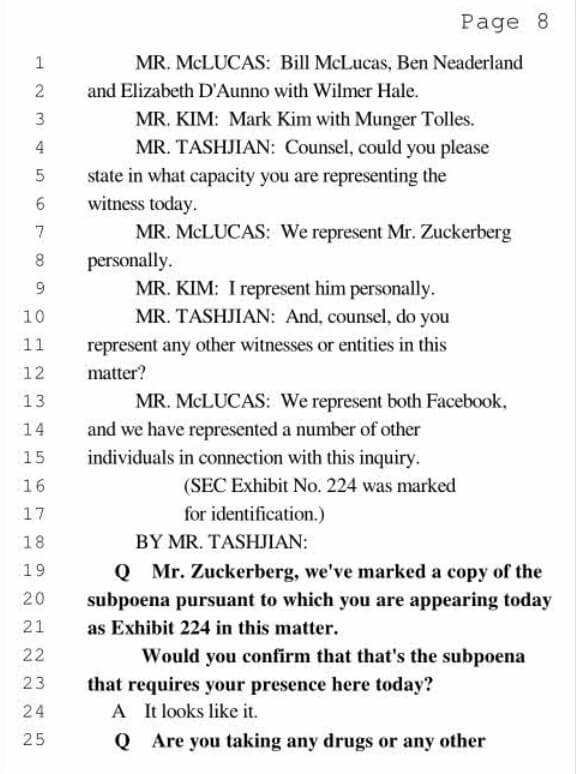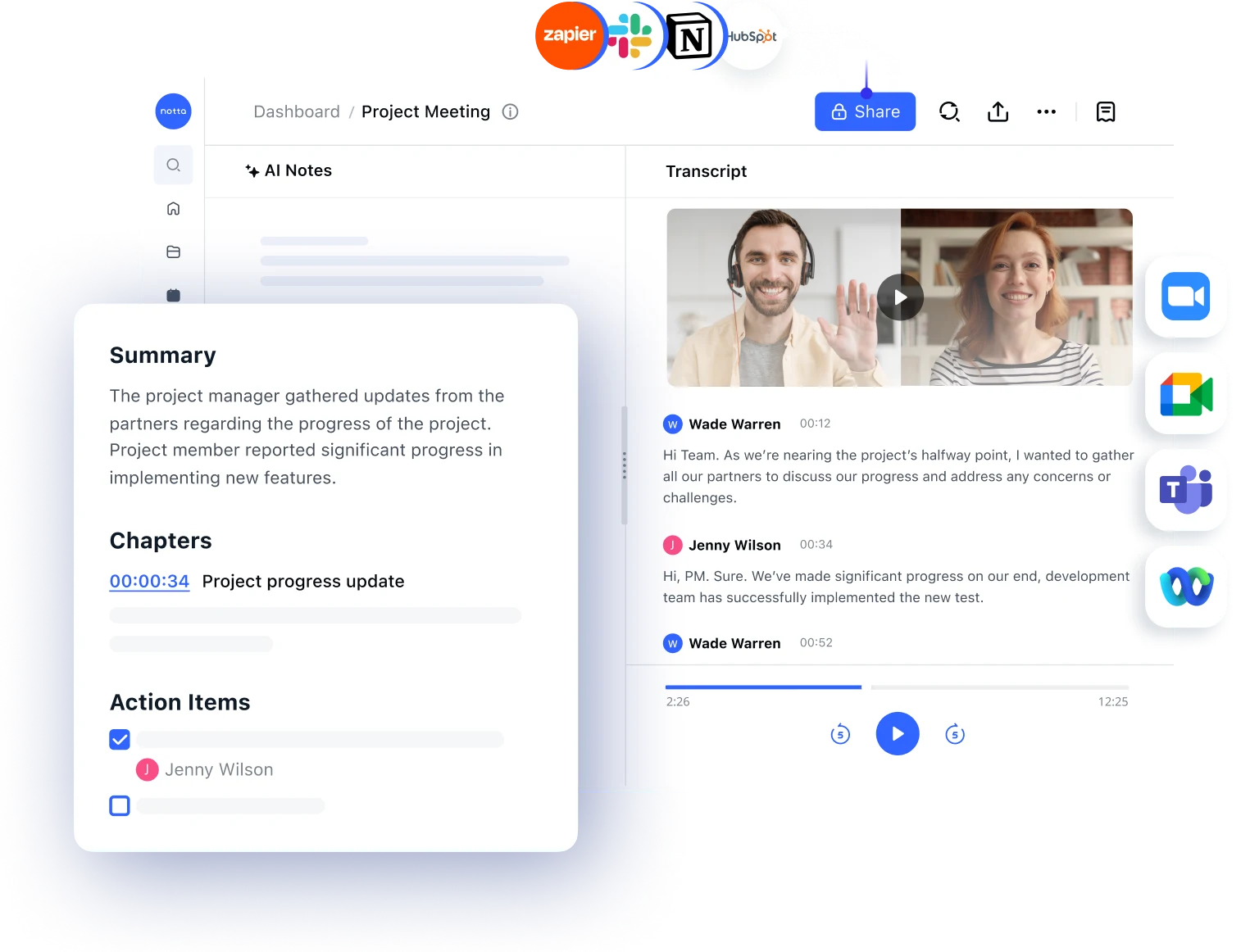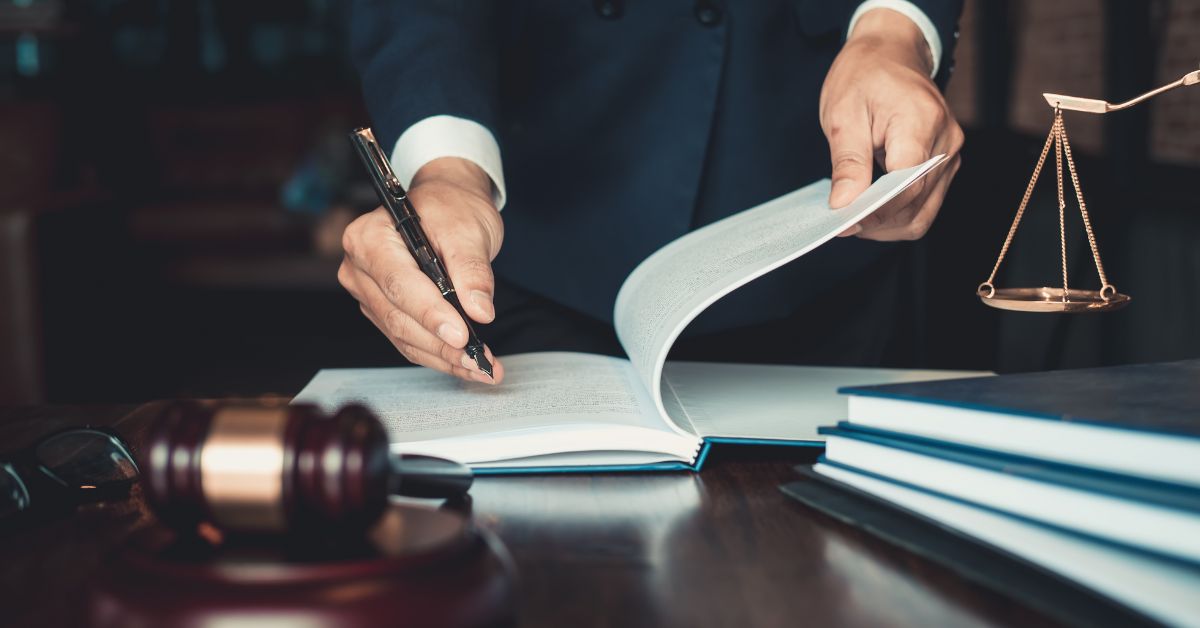Depositions play an essential role in the modern legal process, and accurate transcripts are a key feature of that role. In the past, deposition transcripts and summaries were created painstakingly by hand, but recent advances in AI-based speech recognition have created new opportunities to improve the entire deposition process.
This article highlights the essential features of a perfect deposition transcript and provides tips for best practices throughout the transcription workflow, from creating an initial recording to finalizing your deposition summary.
What is a deposition transcript?
A deposition transcript is an official record of sworn testimony provided during an out-of-court deposition. It provides a complete account of the entire deposition, including all questions posed by attorneys, all answers provided by witnesses, and any objections made during the deposition.

An example page from an SEC deposition given by Mark Zuckerberg
The deposition transcript becomes a foundational document that is frequently referenced at later stages of the legal proceedings. They are used by attorneys on both sides for case preparation, drafting motions, and in-court arguments.
As a result, the accuracy of a deposition transcript is critical to its effectiveness. The slightest mistake or variance from the sworn testimony could have serious legal implications for all parties involved. Deposition transcripts must be certified by a court reporter to ensure perfect accuracy.
How to obtain a deposition transcript
Using court reporters and transcription services
Court reporters are integral to the deposition process. They are responsible for swearing in deponents and creating an accurate, word-for-word record of the entire deposition testimony. These records can be made using various tools and technologies, including shorthand, stenographic machines, or electronic audio recording.
Once the deposition is complete, the court reporter is responsible for creating an accurate transcript to share with the court and all other parties involved. This transcript can be prepared by hand, but it's faster and simpler to use a transcription tool like Notta to convert spoken words into text automatically. The resulting document can be verified for accuracy by the court reporter and submitted as a certified deposition transcript.
Key features of a reliable transcription service
When selecting a reliable transcription service to create deposition transcripts, these are the key features that you should look for:
Accuracy. Deposition transcripts must be 100% accurate, so high accuracy is essential during the transcription process to minimize any errors that must be corrected before the final document is certified as accurate.
Delivery speed. Many legal situations require fast turnaround times. Ensure your transcription service can deliver documents quickly without high costs or reduced accuracy.
Speaker identification. For clarity, transcription services should identify each speaker separately within the source audio recording.
Technical vocabulary. A good transcription service should be able to transcribe specific legal terminology and any required technical terms accurately.
Confidentiality & data security. Many legal proceedings require strict confidentiality, so your transcription service must comply with all local confidentiality and data security laws.
Formatting options. To save time, choose a transcription service that offers multiple formatting options for your documents.
Best practices for accurate deposition transcription
In addition to choosing a reliable transcription service like Notta, there are several practical strategies that you can implement before, during, and after the deposition to improve your overall transcript accuracy.
Use high-quality recording equipment. High-quality microphones will capture the full detail of each syllable, making the transcription process more straightforward.
Test your recording equipment carefully before use. Ensure every device is fully charged and working correctly within its specified recording range.
Select a quiet space. Minimize background noise to ensure that your recording captures all details clearly without interruption.
Position all recording equipment correctly. Many high-quality recording devices have a specific recording range and/or direction. Verify that your recording devices are positioned for optimal recording within your chosen environment.
Use real-time AI transcription. In addition to a complete audio recording, AI transcription services like Notta can provide an unofficial real-time transcript for immediate use, speeding up the process of creating the official transcript.
Speak clearly with an even cadence. When possible, ask participants to avoid rapid speech and strong regional accents to ensure every word is recorded correctly.
Review transcripts carefully. After the deposition, compare the transcript carefully with the audio recording to ensure accuracy. Even unofficial, uncertified transcripts should be accurate.
Use side-by-side review tools. When possible, use a software tool that plays the audio or video recording while automatically moving ahead in the transcript text at a matching speed.
Speed controls. Use a review tool that allows you to slow down the recording playback to simplify the recording/transcript comparison process.
Deposition transcript format and structure
Deposition transcript formats and structure vary from jurisdiction to jurisdiction, but several basic guidelines apply to almost every situation.
Case identification. Before all other considerations, a deposition transcript should identify the specific case it relates to, including any applicable case numbers or docket information. This prevents confusion and ensures that documents are filed correctly.
Participant list. Be sure to include a participant list that includes attorneys, witnesses providing testimony, court reporters, and anyone else present during the deposition.
Timestamps. Timestamps provide details concerning deposition start and end times and tracking breaks or pauses that may not otherwise be recorded as part of the deposition testimony.
Speaker labels. Speaker identification is essential for reading comprehension when reviewing a transcript without the accompanying audio or video recording.
Line numbering. Proper line numbering provides a simple way to direct attention to a specific section of the deposition testimony.
Page numbering. This ensures that no pages are missing from a given transcript and works with line numbers to locate specific passages within the transcript.
Typographic formatting. Many jurisdictions have specific requirements about character spacing, lines per page, indents, and other typographic details that improve readability.
These conventions help improve clarity and reader understanding while providing a simple and direct method to identify specific sections of the transcript for citation when preparing other related documents.
Modern software can assist in the creation and review process for deposition transcripts. Notta provides AI-powered transcripts that include timestamps and speaker identification, and its transcript review process offers multiple playback speeds and automatic time-based text advancement that syncs with your recorded audio or video.

Say goodbye to manual transcription
Use Notta's AI transcription tool to quickly and easily transcribe audio and videos. We guarantee accuracy and ease of use.
How to create a deposition summary
Purpose and benefits of a deposition summary
Depositions often include hours of testimony, and many cases involve multiple depositions filled with complex details. A deposition summary provides a condensed version of a full-text deposition highlighting the key facts and crucial sections of testimony. They are helpful when preparing strategies, arguments, and motions.
Types of deposition summaries
There are several types of deposition summaries used in modern legal proceedings:
Page-line summaries. This summary format condenses specific portions of the transcript containing essential information, using page and line numbers to identify the summarized sections. They are typically presented in a two-column first and provide a high-level summary of lengthy depositions.
Topic summaries. This summary format is organized around specific topics, collating related information regardless of where it appears in the transcript. Topic summaries are often combined with page-line references to locate related areas of testimony.
Chronological summaries. Chronological summaries re-organize the events in a deposition transcript sequentially, from the earliest event to the most recent. They are commonly used in criminal cases, although other cases that depend on a series of connected events can also benefit from a chronological summary.
Narrative summaries. This is the least formal type of summary, used to arrange events into a coherent narrative that makes complex testimony easier to follow.
Steps to create an effective deposition summary
Here's a quick overview of the basic steps used to create a deposition summary:
Review thoroughly. Ensure that you have a copy of the finalized, certified deposition transcript, and review the entire document thoroughly to familiarize yourself with the people, events, and topics involved.
Identify essential testimony. Re-read the document to identify passages of testimony that contain details crucial to the case.
Choose a summary format. Determine which type of deposition summary would be most advantageous. You may find it helpful to start with a page-line summary and then organize further if necessary.
Summarize key passages. Summarize the key passages you identified earlier, using page-line references to locate the original source testimony in the transcript.
Review for accuracy. Carefully review the document to ensure that the summary is complete and free from errors.
Deposition transcript and summary examples
The following examples are fictional. They are designed to improve understanding of the basic format and structure of deposition transcripts and summaries.
Example of a deposition transcript
United States District Court Civil Case No. 24-CV-98765
Deposition of John Doe
Date: December 18, 2024
Location: Law offices of Jane Smith, 123 Fake Street, Anytown, USA
Participants:
[Transcript begins]
James Green:
Q: Can you please state your full name for the record?
John Doe:
A: John William Doe.
Q: Where do you currently reside?
A: 321 Fake Street, Anytown, USA.
Q: Were you involved in a car accident on the evening of October 31, 2024?
A: Yes, I was.
Q: Can you describe what happened?
A: I was driving home from work around 7 pm, traveling south on Main Street. Someone dressed as a monster for Halloween ran out into the northbound lane, and another car swerved to avoid them, hitting my car in the process.
Q: What kind of monster were they dressed as?
Jane Smith: Objection, relevance.
James Green: Withdrawn.
Q: What type of vehicle hit your car?
John Doe:
A: A blue four-door sedan. I didn't recognize the model.
Example of a deposition summary
Let's look at two popular types of deposition summaries: page-line summaries and topical summaries.
Page-line summary
| Page-line | Summary |
| 3:3-11:8 | John Doe describes his actions leading up to the accident. |
| 11:9-12:15 | Testimony regarding the nature of the vehicles involved |
| 12:16-15:4 | John describes the results of the collision impact |
| 15:5-20:2 | John testifies to the nature of his injuries caused by the impact |
Topical summary
Event Description
A four-door sedan traveling northbound swerved into oncoming traffic to avoid a pedestrian.
The sedan struck John Doe's car on the front left bumper.
John Doe's car was pushed onto the sidewalk, where it struck a utility pole.
Medical Treatment
John Doe was assessed at the scene by paramedics, who advised examination by a doctor at a local hospital.
Minor scrapes and abrasions were treated at the scene.
John Doe was diagnosed with a concussion by the on-call doctor at Anytown General Hospital.
Ongoing Issues
Mitigating Circumstances
How Notta can improve your deposition workflow
While Notta can never replace a court reporter's discretion and attention to detail, it is a valuable tool for improving workflows during and after the deposition. Notta can create a highly accurate transcript in real-time during the deposition, which you can use to significantly accelerate the process of creating the official certified deposition transcript.
Notta's transcription review process allows you to easily review both the transcript and the audio/video recording at the same time, which simplifies the process of verifying transcript accuracy. Multiple speed options allow you to control the recording playback speed, and the text advances automatically in sync with the recording.
In addition to improving your transcription process, Notta can also enhance the creation of deposition summaries using AI. You can create summary templates using custom AI prompts that extract key insights and details from your deposition transcript and search through documents instantly to locate topic keywords.
Transcription made easy with Notta
Fed up with slow documentation? With Notta, you can record and access error-free transcripts seamlessly synced across all your devices.
In sum
Deposition transcripts and summaries are a crucial part of the legal system, so they must be both highly accurate and rapidly completed. While it's possible to accomplish this by hand, modern software solutions like Notta can help legal professionals accelerate their document delivery timetables while maintaining a high standard of accuracy and organization.
This article is provided for informational purposes only and should not be considered legal advice.


